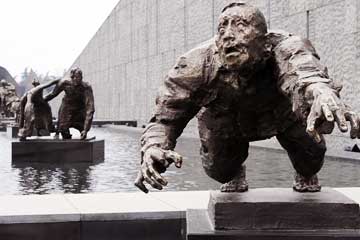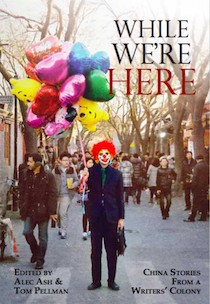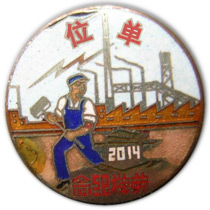Dark Displays
Sightseeing the Nanjing Massacre Museum – by Christian Shepherd

"Alright mate. Where've you got to?" I'm sat on the benches at the exit."
Relieved, I up my pace to a brisk walk. "With you shortly."
"No rush mate – watching an interesting documentary on the author of The Rape of Nanking. You don't want to skimp on the torture and beheadings section."
I slow down. "Hold on – you're still downstairs?"
There's a pause on the other end of the line. "Upstairs? There's more?"
Like any innocent harbinger of bad news, I break it with an apology: "Yeah, sorry. There's a massive section focusing on the aftermath."
"Jesus ... See you on the other side brother."
The line dies. In hindsight, the Nanjing Massacre Memorial may not be the easiest place to rekindle dormant childhood friendships.
***
Since graduating from high school in North Yorkshire, Mat and I have separately taken infant steps towards studying China. A weekend trip to Nanjing is the first attempt to combine old friendship and new discoveries. Keen to bond over a shared interest in Chinese history, politics and society, I suggested we head straight to the Nanjing Massacre Memorial.
The Memorial grounds immediately remind me of visiting WWII concentration camps in Germany. A chilling environment has been created to aid the impossible task of empathising with the victims – angular stone monuments and contorted metal statues are sparsely spaced in a sea of grey gravel. The effect is dampened by a stream of visitors who contentedly jostle through the security-check bottle-neck before surging forth into the central square, submerging the space in clumps of colour-coded cap-wearing tour groups.
After discussing ways to avoid the crowd, we begin with a leisurely stroll around the grounds. The museum, we figure, is best left till noon, when the fabled Chinese lunch hour will clear tour groups like Moses at the Red Sea. At a wall listing victims' names, Mat tells me about a professor of Chinese history who avoids writing about the massacre due to negative mainland reception of revisionist papers – particularly those that question the official death count of 300,000. From a row of information boards detailing Commemoration Day speeches, I voice my belief that the Party is condemning the massacre with greater gusto over time.
In a solemn meditation hall, we stifle laughter at tacky faux candles made from thin paper fluttering above small orange lightbulbs. Standing in a room sheltering the jumbled skeletal remains of a mass grave, we agree that memories of loved-ones murdered in so cruel a manner must be an unshakable weight on the minds of the survivors.
Midday nears, and noting the emptiness of the Peace Park – a space at the far end of the grounds built around a tall white statue of a woman holding up a dove and an infant – we decide lunchtime is nigh. But back at the central square, the kaleidoscopic hats swirling around the museum's entrance show no sign of abating. Resigned to our fate, we follow the crowd into the building's dark entrance. A foreboding sense of unease begins to churn in my stomach as I walk down the dimly lit stairs to the basement exhibits below. It's going to be rammed.
Past a slick black-marble entrance hall, we enter the labyrinth of the museum proper. There’s a dense atmosphere throughout the downstairs section, where narrow hallways are designed to resemble nighttime Nanjing in late 1937, crumbling under the attack of Japanese bombers. Mat and I realise that navigating through the barrage of information and shoving crowds is a mission best undertaken alone. We each go our separate ways, agreeing to regroup at the exit.
Ever since I began to study China properly, I've taken a meticulous approach to museum visits. This entails regularly standing against a current of speeding tourists who stay at each display just long enough to snap a photo before marching on. Today, I am content to by carried through the exhibits by the viscous flow of visitors, who take their time over each display, attentively drinking in gory details of the Japanese invasion.
While my feet shuffle round rabbit-warren hallways, my mind sifts through all the data on display. The exhibits are a smorgasbord of diverse, yet carefully selected, perspectives on the event. I read citizens’ painful memories, soldiers' confessions, and foreign businessmen’s diaries about everything from invasion to occupation to slaughter. Each display is a dizzying collation of facts, figures, pictures, primary source material, exposition of historical methodology and detailed explanation. The ensemble builds and builds until narratives coalesce into a crescendo of mass graves, rape, torture and beheading.
Standing in front of the grainy picture of a smiling Japanese soldier raising a curved sword high above the neck of a young man kneeling in prayer, the buzz of my over-worked mind goes silent. There is just too much to take in. I’ve abandoned my attempts to seek academic truth from this informational onslaught, and view the remaining exhibits through glazed eyes, soaking in the undercurrent of despair, disbelief and anger.
At the end of the downstairs section, a row of benches stand beneath a two-story-high wall of "files" (mostly empty binders), meant to signify the vast wealth of data underwriting the museum's claims. I sit for a while among the picnicking guests, counting the disconsolate faces of passers by before braving the escalator upstairs.
***
Here, in expansive well-lit rooms which are a stark contrast to the darkness below, I read about China's post WWII (or, for the large part, post 1949) rejuvenation. Chinese visitors sweep through these exhibits at a brisk pace, like I’m used to. After a while, I sense Mat may also be bogged down in information overflow, and call to find out how he's getting on. Waiting for him by the exit – a sky-blue archway adorned with doves – I read the final display, a collection of photos and descriptions paying homage to visiting Party leaders. All the big names are present. No prudent political leader would ignore the deep well of emotion to be found in these halls.
Silence as Mat and I exit the museum. Shell-shocked and exhausted, we can’t even attempt an analysis of what we’ve seen. Eventually, recognising some comment must be made, we agree the memorial was “fascinating" and talk about where to go for dinner.
Three weeks later, we meet up again in Beijing for an evening of street-side skewers and iced Yanjing beers. When the conversation moves to Nanjing, it turns out our stupefied response didn’t last. The museum exhibits now fit conveniently into familiar historic, political and social narratives. It’s one of those quasi-academic and mostly pretentious discussions about China that go well with chuanr. Filtering fact and propaganda requires good company and the right degree of separation from what you’re talking about. To have both is a privilege.
•
Christian Shepherd is a student, attemptive hack and writer based in Beijing. He also writes a blog on China, Theseus’ Thread. Follow him on Twitter @cdcshepherd




















